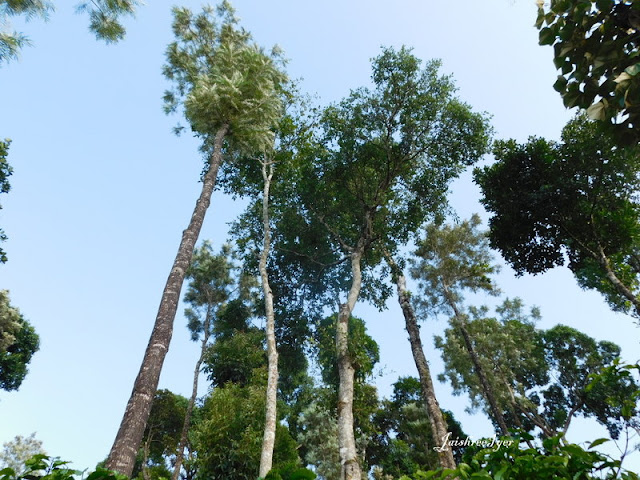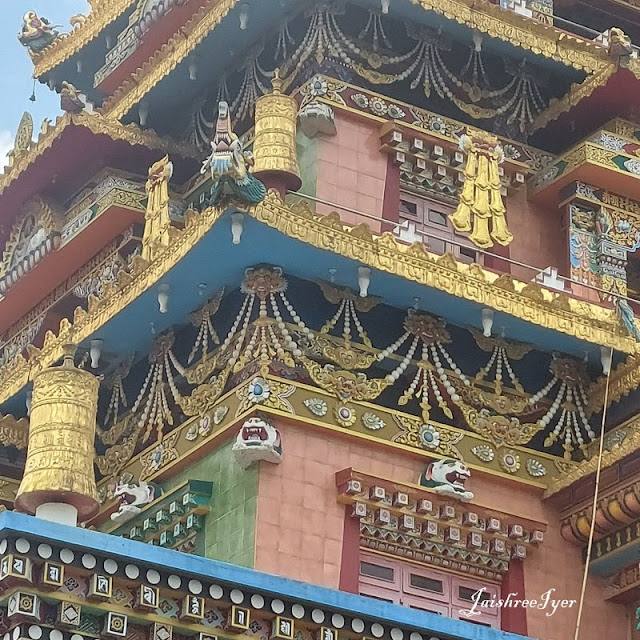The way to Coffee-Exploring Coffee
Plantations Coorg
Many people love coffee, and I am a coffee Lover.The
first sip in the morning is a heavenly experience tantalizing the taste buds in
a whirl of decadent flavours, rolling through their tongue, and introducing new
sensations to their senses of smell and taste. Good coffee soothes your
stomach, the host of the majority of your arteries and delivers an excitable
feeling to the rest of your body
It first starts with infatuation,
but as you get to know it more and more, you begin to love the drink, the
smell, the taste, the way it is made, the way it looks, where to drink it, how
it all started –To know more we visited Coffee Plantations.

Exploring Coffee Plantations
while our visit to Coorg was not on the list. But as suggested by our driver,
we headed towards one of the private properties that he was aware of. He
introduced our group to the guide of the property in Madikeri. Madikeri is
known for its resplendent coffee plantations and green meadows sprawling over
acres of land. The area is popular for its premium class coffee beans. One of
the best activities to do in Madikeri is to take a walk through these gorgeous
coffee plantations.
Evergreen forest in Coorg
sustaining the Life of Coffee
We always heard that Coorg is
famous for its coffee and spices. But rarely did we have any idea and insights
about it. The host seemed to be kind and generous about the work and efforts
they are putting into creating these coffee plants. We started following him as
he introduced us to the quiet piece of heaven in the midst of hilly regions.
Coorg is most popularly nick-
named as the 'Coffee Cup of India'. The mountainous area of Coorg is strongly
reminiscent with the blend of the aroma of fine Arabica and Robusta and they
are supposed to be the world's best coffee.
History of Coffee in India
The history of coffee in India is
nearly four hundred years old and it belongs to the 17th century. History tells
it that in 1670, a Muslim pilgrim named Baba Budan snuck seven coffee beans in
his beard aboard a ship to India. Upon arrival, he planted these beans in the
Chikmagalur region near Coorg in Karnataka. At this time, it was illegal to
transport green coffee beans outside of Yemen, and the ports were strictly
monitored in an effort to maintain a monopoly on local coffee production and
trade.

Baba Budan was not only successful at sneaking
them out of Yemen but also successfully planted them in Chandragiri Hills.
Legend has it that the Baba had his friends carry the beans with them and plant
them wherever they went, mostly in gardens and backyards. Coffee production
prospered in Chandragiri Hills over the next century. However, the bean didn’t
spread throughout other parts of India until the 19th century, when coffee
started being exported for trade. Coffee now flourishes in Karnataka, where the
slopes of the Western Ghats are brought to life with the fresh aromas of
arabica and robusta plants.
The first thing he showed us were
the two main varieties of coffee. Varieties of Coffee:
They separate both the species
with a road in between so as to differentiate between them properly. There is a
major difference between their size, taste, and type of growth.
1. Arabica:
Arabica has a softer, sweeter
taste and it grows at a height of 7-8 feet. The berries grow randomly on its
small stems with soft branches. The maintenance cost of Arabica is greater than
the other variety as the insects affect it more due to its small and soft stem.

2. Robusta:

Robusta contains higher caffeine
resulting in a bitter taste. It stands more than 10 feet with harder branches
and big stems. The berries of Robusta grow in clusters.
Growth of the Coffee Plantations
in Coorg:
Arabica is superior to robusta in
the markets which creates more demand for Arabica. It counts for 70% of the
production while Robusta counts only 30%. Both species yield 2 crops per year.
The lifespan of a coffee plant is 30-35 years. When it starts from a bean, it
takes 3-4 years for the first yield and then every year ahead.
Coffee Plantations
The first flower buds start
growing in the branches in February and March. There is a term for the first
rain that falls on these coffee buds, called the “Coffee rain”.
Coffee Flowers
Can you smell the flowers?
Doesn’t it smell like jasmine?”, my guide asks me. He is right. I notice a
discernible scent of jasmine permeating the air as we walk through rows of
blossoming coffee trees. “When the coffee trees are ripe, they have small,
white flowers that smell like jasmine.” The rows of arabica and robusta trees
hang heavy with burgundy-colored fruit and delicate white flowers. Interspersed
among the blossoming coffee trees are ladders of pepper vines climbing into the
sky.

He explained when the coffee rain
starts pouring, the flowers start blooming from the buds. These white-colored
coffee flowers depict jasmine flowers in their appearance and smell. They are
visible only 2 days in a single year. After the flowers bloom, the next day
itself they will dry and fruit buds start opening from them.

The fruit buds start growing
bigger. First, there will be green color berries which further turn yellowish.
After a few days, they turn into crimson red color berries. These crimson red
berries are the perfect ones to harvest.

After harvesting the crimson red
berries, inside there will be two beans. They use these beans for coffee and
the outer cover called musk as a compost. The beans are then dried, roasted and
finally red Crimson Red Coffee Berries.

They plant trees that grow huge
after some years and form a dense forest to provide shed for the coffee plants.
Coffee plants need 40% of the shed to grow rich. for serving into a cup.
Kopi Luwak – the world’s most
expensive coffee is also found here.
This is a Civet Cat that consumes
the selected coffee berries and it removes the outer cover. The beans along
with mucilages pass into its digestive system. It mixes with all the enzymes
and nutrients which ferment the beans and they will defecate it. The defecated
material along with other fecal matter is collected and sold as Kopi Luwak
coffee.
A cat’s poop serving as a coffee.
Strange, isn’t it? Evolve Back hosts a coffee tasting for its guests to try
different roasts and ways to brew coffee, from cappuccino to Vietnamese, and
including India’s very own coffee, known as Kaapi. Amid the thick green coffee
plantations and the stirrings of the surrounding jungle, the barista carefully
pours steaming cups of Kaapi.
Spices in the Coffee Plantations
of Coorg:
The mainland of Indian coffee is
distinguished for its featured monsoon-fed coffee which is mostly grown in the
shades of huge Rose Wood, Wild Fig and Jack Fruit trees. The place is not only ideal
for coffee but also promotes distinct eco-system for it is the home for great
birds and animals like the Great Indian Pied Hornbill and the Giant Malabar
Squirrel which are attracted by the fruit laden trees with rare flavors and
aroma.

Coorg coffee encourages other
cultivations like pepper, cardamom, vanilla, orange and banana.. It also
promotes intercropping like Pepper, (You can see different types of pepper such
as white, green and black pepper). Cloves, Cardamom, Kokum (Garcinia cambogia)
and Cinchona paving way for a spice country.

Coorg cultivates all of its coffee
under a well-defined two-tier mixed shade canopy, comprising evergreen
leguminous trees.

The displays extended by the
coffee plantations are just beyond one’s imagination and one must not date to
miss out on a chance to tour them. Though the robusta beans are tall and can be
spotted from anywhere, the arabica is short shrubs. If you are looking for a
soulful retreat then this is one of the most scenic places where you can tour
the coffee plantations and also stay amidst them.

I spent hours to meandering
through thick growth of native trees, vanilla, turmeric, cinnamon, ginger, and
black pepper crops; and coffee trees heavy with ripened arabica and robusta
beans.

The growth of the rainforest canopy is left natural, allowing for the
fungi, spiders and insects native to the ecosystem to their important role in
the ecological coffee and spice farming in this region. There are two different
climates in Coorg—rainforest and dry, temperate forests—both of which are
friendly for coffee growing conditions.

With a tour to the lush green
trails of coffee plantations of Coorg, you can learn about the robusta &
arabica beans that are grown in the region. Right from the process of selecting
the riped coffee beans to the process of harvesting them, here, you can know
about everything at once. The experience of touring the coffee estate is one of
its kind as the breath-taking views along with the soothing vibe are just the
right dose for the visitors!

While returning they gave a cup
of coffee I couldn’t resist tasting the smooth, flavourful specialty. I savoured
the few sips my taste buds were spinning. I was experiencing flavours I allowed
myself to indulge in, when the coffee cooled the flavors transformed into
something completely different





































